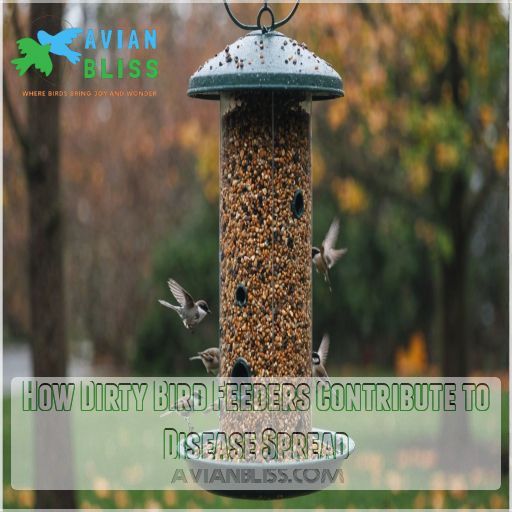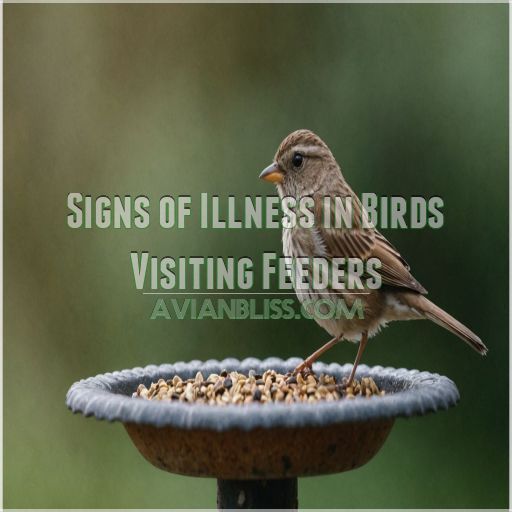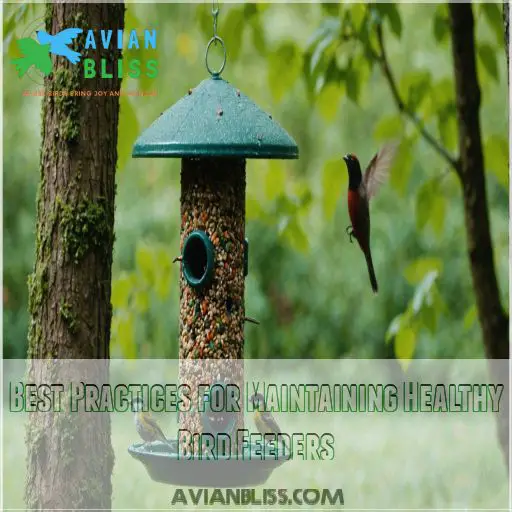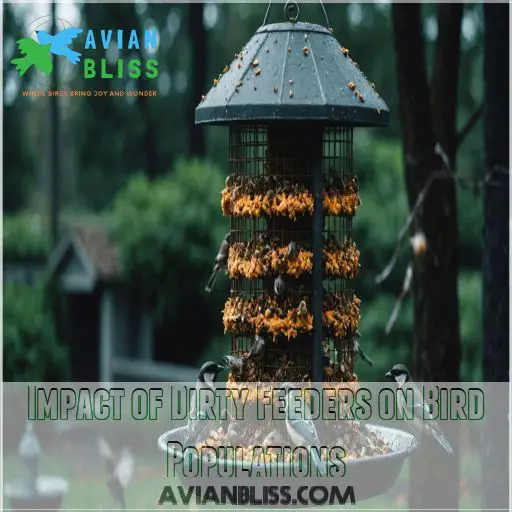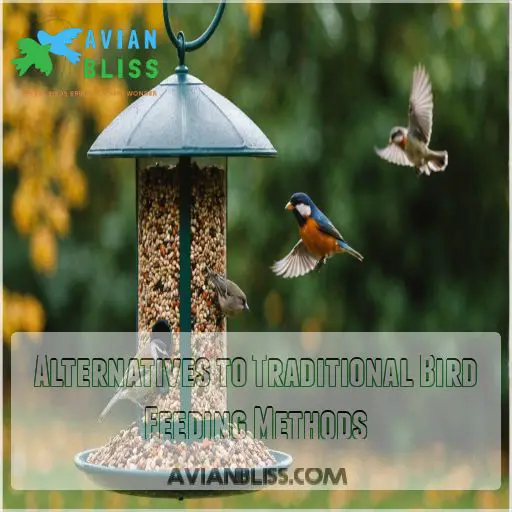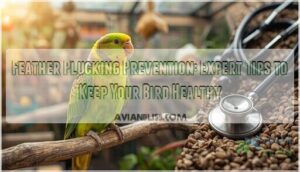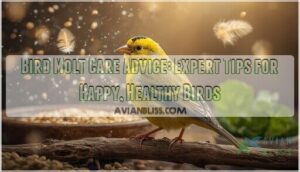This site is supported by our readers. We may earn a commission, at no cost to you, if you purchase through links.
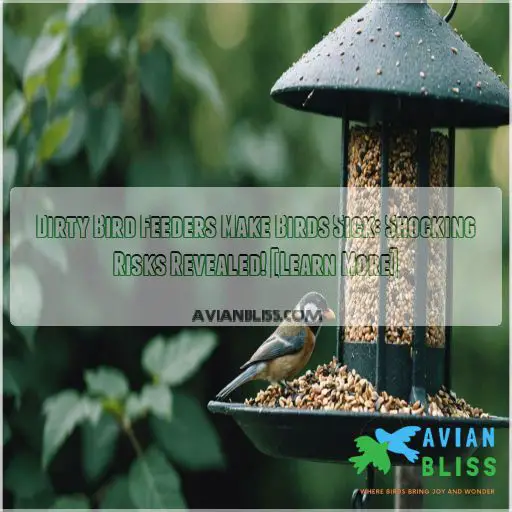
Imagine this: your bird feeder is like a bustling café for feathered friends.
But when droppings and old seeds pile up, it turns into a health hazard, breeding bacteria and parasites.
Imagine a crowded café with no cleaning staff—yikes!
Birds can catch illnesses from contaminated food or from each other, especially if feeders aren’t cleaned often.
Regular cleaning with simple solutions like vinegar and sunlight helps keep your avian visitors happy and healthy.
Curious about the best cleaning techniques to prevent these nasty diseases? Stay tuned!
Table Of Contents
- Key Takeaways
- Common Diseases Spread Through Dirty Bird Feeders
- How Dirty Bird Feeders Contribute to Disease Spread
- Signs of Illness in Birds Visiting Feeders
- Proper Cleaning Techniques for Bird Feeders
- Best Practices for Maintaining Healthy Bird Feeders
- Impact of Dirty Feeders on Bird Populations
- Alternatives to Traditional Bird Feeding Methods
- Responsible Bird Feeding for Conservation Efforts
- Frequently Asked Questions (FAQs)
- Can bird feeders make birds sick?
- How often should bird feeders be cleaned?
- Can you get bird mites from a bird feeder?
- What are the negative effects of bird feeders?
- Can climate affect disease spread at feeders?
- How does feeder placement impact bird health?
- What materials are ideal for bird feeders?
- Are certain birds more susceptible to diseases?
- How can seasonal changes influence feeder hygiene?
- Conclusion
Key Takeaways
- Cleaning your bird feeders regularly is essential to keep them free of harmful mold. Think of it as tidying up your bird’s favorite café to keep diseases like salmonellosis and avian pox at bay. A spritz of vinegar and sunlight does wonders.
- Don’t let your feeders become crowded parties. Birds packing into tight spaces can lead to a disease carnival. Rotate feeding sites and moderate the bird buffets to maintain a healthy backyard sanctuary.
- Keep an eye out for sick birds. If your feathered friends seem under the weather, with droopy wings or swollen eyes, give your feeders a thorough cleanup. Treat it as an urgent memo from the avian health department.
- Consider ditching traditional feeders for a bird-friendly landscape. Plant native shrubs or add water features—a natural paradise without the messy strings attached, offering birds what they need sans the disease risks.
Common Diseases Spread Through Dirty Bird Feeders
You might be surprised to learn that your backyard bird feeder could be a hotspot for diseases like salmonellosis and avian pox.
By understanding what these diseases are and how they’re spread, you can keep your feathered friends safe and healthy.
Salmonellosis in Wild Birds
Salmonellosis symptoms in sick birds can be as nasty as finding gum on your shoe.
Keeping bird feeders clean is key to preventing this disease and avoiding pesky chipmunks.
Droppings and spoiled seeds are prime salmonella sources.
Maintain feeder hygiene by regularly changing food and cleaning surfaces.
Prevent bird diseases by keeping everything tidy, ensuring our feathered friends don’t check into the “sick” list.
Avian Pox Transmission at Feeders
Avian pox can spread like wildfire at bird feeders, where hygiene takes a backseat. These viral infections cause wart-like growths, giving birds an unwanted makeover.
To keep bird health in check, wash feeders regularly and avoid overcrowding.
Don’t let your feeders become a hotspot for disease transmission. Remember, clean feeders mean happier, healthier birds.
Trichomoniasis Outbreaks Among Feeder Birds
Trichomoniasis, a nasty parasite, can quickly spread among feeder birds.
This upper-digestive disease has been linked to declines in greenfinches and chaffinches.
To keep your feathered friends healthy:
- Clean feeders weekly with a 10% bleach solution.
- Rotate feeding sites to prevent waste buildup.
- Discard any wet or moldy seed.
- Monitor birds for signs of illness.
Aspergillosis Risks From Moldy Seed
As you’ve set up snacks for backyard birds, notice the forgotten moldy seed. Mold sneaks around like an uninvited guest, sparking aspergillosis, a respiratory villain in birds.
To keep bird safety in check, commit to feeder cleaning, moldy seed removal, and smart bird feeder storage.
Seed spoilage prevention isn’t rocket science; it’s like realizing you can’t stash sandwiches in the sauna!
How Dirty Bird Feeders Contribute to Disease Spread
You might think you’re helping birds by setting up a feeder, but neglecting to clean it could turn it into a hotbed for disease.
Picture a crowded buffet where diners leave their mess behind; the droppings, moisture, and leftover food create a perfect storm for spreading illnesses among our feathered friends.
Accumulation of Droppings and Food Waste
You’re keeping your bird feeders spick and span, right?
Accumulated droppings and food waste can turn your backyard into a birdie’s health hazard!
Waste becomes a breeding ground for bacteria like E. coli and Newcastle disease, putting bird health—and even human health—at risk.
Prioritizing feeder maintenance and good hygiene practices helps keep everyone chirping happily, so don’t wing it!
Overcrowding at Popular Feeding Stations
When your backyard bird feeders become overcrowded, it’s like a recipe for disaster.
Too many feathered friends crammed into one space can turn your cozy feeding station into a breeding ground for nasty diseases.
Ease up on the buffet, my friend – moderation is key to keeping your backyard birds happy and healthy.
Cross-species Contamination at Shared Feeders
Imagine a bustling bird party where everyone’s mingling – but that party’s your backyard feeder. Different bird species, like uninvited guests, spread disease rapidly among close-knit, feathered friends. Cross-species contamination is a real threat!
Keep things tidy with regular cleaning to help maintain the bird diversity.
Consider feeder design and hygiene practices to limit population density, and prevent unwanted disease transmission.
Moisture Retention Promoting Bacterial Growth
Sharing feeders is like inviting bacteria to a never-ending party. Moisture retention creates a breeding ground for mold and fungal spores that latch onto damp seed. Keep those pesky bacteria away with good hygiene!
- Dry seeds to prevent sogginess
- Make sure drainage holes aren’t blocked
- Avoid low-lying areas where water might gather
Signs of Illness in Birds Visiting Feeders
When birds at your feeders start acting like they’ve had too many late nights, it’s time to be a bit of a bird detective.
From lethargy and labored breathing to cartoon-style swollen eyes, spotting these signs early can help you keep your backyard flock healthy and happy.
Lethargy and Reduced Activity Levels
If your feathered friends seem a bit under the weather, with drooping wings and sluggish movements, it could be a sign of trouble. Lethargy and reduced activity levels may indicate an underlying illness linked to dirty bird feeders. Act quickly to clean your feeders and monitor your birds closely. Their health and wellbeing depend on it.
Lethargy and reduced activity levels may indicate an underlying illness linked to dirty bird feeders. Act quickly to clean your feeders and monitor your birds closely. Their health and wellbeing depend on it.
| Symptom | Potential Cause |
|---|---|
| Lethargy | Salmonella, Trichomoniasis |
| Reduced Activity | Avian Pox, Aspergillosis |
| Fluffed Feathers | Respiratory Distress |
| Loss of Appetite | Digestive Issues |
| Labored Breathing | Fungal Infections |
Visible Lesions or Growths on Skin
Lethargy isn’t the only red flag. Visible lesions or growths on a bird’s skin, indicators of ailments like avian pox, can spell trouble. Pay attention to these signs if you value bird health.
Keep feeder hygiene excellent:
- Imagine a bird’s skin as your dashboard, warning lights and all.
- Nobody likes unwelcome spots, including birds!
- Guard against skin lesions with regular cleaning.
Respiratory Distress and Labored Breathing
Seeing birds at feeders with visible lesions can be troubling, but noticing respiratory distress is a whole new ballgame. Breathing problems in birds, like labored breathing, signal potential issues.
Keep feeders clean! Moldy seeds and crowded spaces are causes of respiratory distress.
Swollen Eyes or Conjunctivitis Symptoms
While breathing issues give you pause, spotting swollen eyes can be eye-opening. House Finch Eye Disease, a common conjunctivitis in birds, can spread like wildfire at crowded feeders. Look for signs of redness or swelling. For bird eye health, conjunctivitis treatment is tricky, but preventative measures like cleaning feeders can keep things from getting out of hand. Keep an eye on it!
Proper Cleaning Techniques for Bird Feeders
Dirty bird feeders can become breeding grounds for bacteria and illness, regular cleaning and disinfection are crucial steps in bird care, learn how to clean a bird feeder. Keeping your bird feeders clean is important to maintaining the health of your feathered friends.
From disinfecting with the right solutions to proper scrubbing techniques, we’ll show you how to make sure your backyard oasis stays safe and inviting for your avian visitors.
Frequency of Cleaning Based on Usage
Spotting a sick bird can be heartbreaking, but fear not! You can keep your feathered friends healthy by cleaning feeders based on their usage.
Quick guide:
- For high-traffic feeders, aim for Daily Cleaning.
- Weekly Cleaning suits most feeders.
- Seasonal Cleaning makes them ready for migrating birds.
- Keep it cool with more frequent cleans for low-traffic feeders when conditions get messy.
Effective Disinfectants for Feeder Sanitation
Once you’ve figured out how often to clean your feeders, deciding on the right disinfectant becomes your next big win. A bleach solution cleans like a charm. Prefer natural? Vinegar’s efficacy isn’t just a grandma’s tale. Dish soap offers reliable sprucing, and natural disinfectants keep things eco-friendly. Not sure if it’s scrubbed enough? UV sterilization takes cleanliness to new heights.
Scrubbing Methods for Various Feeder Types
When cleaning plastic feeders, give them a good scrub-down with dishwashing safety in mind.
For wooden feeders, use a gentle scrub to avoid damage.
Metal feeder cleaning is a breeze—treat it like a knight’s armor needing polish.
Use these scrubbing tips to fight diseases:
- Prevent illness
- Ensure bird safety
- Enjoy cleaner outdoor spaces
Drying and Storage Practices Between Uses
After scrubbing your feeders, be sure to thoroughly dry them before storing. Air-drying in the sun is best, as it helps kill any lingering germs.
Store clean feeders in airtight containers to keep them fresh and ready for your feathered friends.
Cleaning frequency depends on usage, but aim for at least weekly to maintain a healthy backyard oasis.
| Drying Method | Pros | Cons |
|---|---|---|
| Air-Drying | Natural, effective | Time-consuming |
| Sun-Drying | Disinfecting UV rays | Weather-dependent |
| Enclosed Storage | Protects from pests | Potential moisture buildup |
Best Practices for Maintaining Healthy Bird Feeders
You’ve put up a bird feeder to enjoy watching your feathered friends, but a dirty feeder is like inviting them to dinner in a germy restaurant.
Keep those beaks healthy by rotating feeder locations, offering the right food, and cleaning regularly—your backyard birds will thank you with cheerful chirps and sprightly hops!
Rotating Feeder Locations to Prevent Waste Buildup
You’ve scrubbed your feeders till they shine, but where you stick ’em matters too! Shift feeders like a game of musical chairs. Why? It:
- Reduces waste buildup
- Protects soil health
- Encourages varied bird behavior
- Enhances yard design
Feeder placement is key! Birds won’t stop by if your yard smells like yesterday’s bird banquet. Explore nature’s happy dance!
Offering Appropriate Food Types and Quantities
Imagine a bird feeder as a gourmet restaurant; you need the right menu! Offer a seed variety to attract different bird species, but practice portion control to prevent waste, especially when providing mealworms for your birds. Store seeds properly to maintain seed quality. Here’s a quick guide:
| Element | Tip |
|---|---|
| Seed Variety | Attract diverse birds |
| Portion Control | Prevent overcrowding |
| Food Storage | Use airtight containers |
| Seed Quality | Avoid moldy or stale seeds |
| Feeder Type | Match to bird size preferences |
Keep your feeders fun and safe!
Monitoring Feeders for Signs of Contamination
Keeping a close eye on your feeder is key – look for any suspicious buildup of bird droppings, mold growth, or stale seed. If the birds seem lethargic or are avoiding the feeder, it’s time for a deep clean. Remember, a little vigilance goes a long way in maintaining a healthy, happy backyard flock.
- Check for droppings, mold, or stale seed accumulation.
- Monitor bird behavior for signs of illness or discomfort.
- Inspect feeder surfaces for cleanliness and any contamination.
- Address issues promptly to prevent disease transmission among your feathered friends.
Seasonal Considerations for Feeder Maintenance
Monitoring feeders is part of keeping birds healthy, but let’s talk seasonal tips. Winter cleaning prevents freezing seed messes. Spring cleaning is like a fresh start, shaking off winter’s gunk. Summer insects adore feeders, so tackle that. When fall rolls in, focus on seed storage as cozy weather brews. Keep old man winter at bay by staying a step ahead.
| Season | Focus | Tip |
|---|---|---|
| Winter | Cleaning | Prevent freezing messes |
| Spring | Fresh Start | Shake off winter’s gunk |
| Summer | Insects | Tackle unwanted guests |
| Fall | Seed Storage | Prepare for cozy weather |
Impact of Dirty Feeders on Bird Populations
Dirty bird feeders can lead to local population declines as diseases spread like a bad cold in a crowded classroom, affecting bird communities and even altering migration patterns.
You’ll help protect the feathered friends’ health and diversity by keeping those feeders clean and not turning them into birdie buffets.
Local Population Declines Linked to Disease Outbreaks
When diseases run rampant due to dirty bird feeders, local bird populations might dwindle faster than you’d expect. Here’s how it happens:
- Birds congregating at unclean feeders become hotspots for infection.
- Frequent disease outbreaks can impact population trends negatively.
- Poor feeder hygiene accelerates these disease impacts.
- Without proper conservation efforts, habitat loss compounds the decline.
Feeder hygiene matters—don’t wing it!
Long-term Effects on Species Diversity
While dirty bird feeders may seem harmless, the long-term effects on species diversity can be quite alarming.
As certain birds become more reliant on these artificial food sources, the natural balance of your local ecosystem can shift dramatically.
Take a look at this table to see how feeder dependence impacts avian communities over time:
| Time Period | Species Diversity | Ecosystem Changes |
|---|---|---|
| 1-3 Years | Moderate Decline | Gradual Shifts |
| 5-10 Years | Significant Drop | Noticeable Impacts |
| 10+ Years | Severe Depletion | Major Disruptions |
By being mindful of these long-term consequences, you can make more informed decisions about bird feeding and help maintain the vibrant diversity of your backyard avian residents. Learn more about safe bird feeding.
Altered Migration Patterns Due to Feeder Dependence
Feeder dependence can throw birds’ migration timing off-kilter, despite their best intentions. Imagine birds missing their travel cues, causing evolutionary impacts like missed breeding or unfavorable climates. Here’s the scoop:
- Migratory confusion
- Altered travel routes
- Climate change challenges
- Increased habitat loss
- Unexpected energy usage
Without balance, our well-meaning seed buffets can turn nature’s dance into a tangled waltz.
Genetic Implications of Disease-weakened Populations
Imagine this: weak bird populations at risk! Disease-weakened birds face a genetic rollercoaster.
With selective breeding and reduced genetic diversity, they struggle to adapt.
Diseases can alter evolutionary paths, affecting resistance.
Check out the table below:
| Concern | Impact |
|---|---|
| Genetic Diversity | Decrease |
| Disease Resistance | Impaired |
| Evolutionary Impact | Altered paths |
| Population Decline | Accelerated |
Don’t let dirty feeders mess with nature’s balance!
Alternatives to Traditional Bird Feeding Methods
While traditional bird feeders can pose risks, there are safer, more natural alternatives that allow you to support your feathered friends.
Consider creating a bird-friendly landscape with native plants or installing a water feature – both provide birds with the resources they need without the potential for disease transmission.
Native Plant Landscaping for Natural Food Sources
Consider native plant landscaping to attract birds naturally instead of relying on feeders.
Choosing native plants promotes habitat restoration and enhances backyard biodiversity, attracting pollinators with effortless bird-friendly design.
You offer a buffet of seeds and berries, but you also create a safe, more balanced environment for birds and your yard’s blossoming biodiversity.
Who knew landscaping could be this rewarding?
Water Features as Safer Attraction Points
Water features offer safe alternatives for attracting birds without the disease risks associated with dirty feeders learn more about bird dietary needs.
Make your yard a bird paradise with:
- Bird baths that mimic natural water sources.
- Ponds with safety measures to prevent drowning.
- Flowing streams for a tranquil environment.
- Frequent cleaning to keep the water healthy.
- Rocks and shallow edges for easy drinking.
Your feathered friends will thank you!
Creating Diverse Habitats to Support Birds
Creating diverse habitats supports birds better than bird feeders.
Transform your backyard with native plant selection and habitat restoration.
Bird-friendly gardening turns your space into a bird paradise, and urban wildlife will thank you.
They’re more than just pretty faces—plants are the lunch buffets of the avian world.
Seasonal Feeding Strategies to Reduce Risks
Instead of leaving your feeders up year-round, try a seasonal approach.
During winter, offer high-energy foods like suet and nyjer seed to help birds survive the cold.
Come spring, switch to a variety of seed types and rotate feeder locations to discourage disease transmission.
Regular cleaning is a must – aim for weekly during peak seasons.
Responsible Bird Feeding for Conservation Efforts
You might think feeding birds is just tossing seeds, but doing it responsibly is really important for their health and conservation.
Join citizen science projects, clean feeders regularly, and you won’t just be a snack provider – you’ll help save wildlife!
Citizen Science Projects Monitoring Feeder Birds
Imagine joining forces with nature lovers worldwide through citizen science projects like FeederWatch! You track important data collection methods and uncover long-term trends.
Here’s how:
- Engage in disease surveillance.
- Share findings with fellow bird enthusiasts.
- Analyze FeederWatch data for insights.
- Participate as a citizen scientist contributing to bird conservation.
Together, you’ll help keep our feathered friends safe and healthy!
Educating Communities About Feeder Hygiene
Contributing to citizen science projects is rewarding, but being aware of bird health at feeders is equally important.
Educate your community about feeder cleaning and disease risks.
Think of a dirty feeder as a bird’s germy "food court".
Encourage safe feeding practices to protect bird health by providing healthy alternatives to bread.
Balancing Human Interaction With Wildlife Health
Balancing your desire to connect with nature through bird feeding and ensuring the health of local wildlife populations is a delicate dance.
By embracing citizen science projects, you can contribute valuable data to help experts guide responsible feeding practices that benefit both birds and your community.
It’s a win-win for everyone!
Collaborating With Wildlife Experts for Best Practices
Working with wildlife experts is like having a GPS to guide your bird feeding practices.
You’ll get expert advice on feeder design and habitat management, enhancing disease prevention and preservation through citizen science.
Embrace their knowledge to make informed choices, creating a safer environment for both you and your feathery friends.
After all, two heads are better than one!
Frequently Asked Questions (FAQs)
Can bird feeders make birds sick?
Did you know Americans spend over $5 billion annually on bird food?
While feeders can be a joy, they also pose risks.
Keep your feeder squeaky clean to prevent diseases from spreading among your feathered friends.
How often should bird feeders be cleaned?
You should clean your bird feeders weekly to prevent disease and keep our feathered friends healthy.
Think of it like cleaning your kitchen: a quick scrub keeps it spick-and-span and the diners happy!
Can you get bird mites from a bird feeder?
Bird mites usually live on birds, not feeders.
They accidentally come to feeders if birds or nests are nearby.
These pesky critters don’t reproduce on human blood, so you’re safe, but regular cleaning helps prevent mites (Source).
What are the negative effects of bird feeders?
Imagine a crowded party where germs mingle too freely.
Dirty bird feeders can create such a scenario, leading to disease transmission, attracting unwanted wildlife, and making birds feel a bit too cozy for comfort.
Can climate affect disease spread at feeders?
Warmer temperatures and increased precipitation can create ideal conditions for disease-causing pathogens to thrive, amplifying the risks at your bird feeders.
Stay vigilant and clean those feeders regularly to keep your feathered friends healthy.
How does feeder placement impact bird health?
Imagine this: Your bird feeder is a bustling café for your feathered friends.
Placing it near windows reduces predator threats but watch for collisions!
Keep it away from humid spots to prevent mold and disease, ensuring avian health.
What materials are ideal for bird feeders?
Choose metal, plastic, or mesh materials for bird feeders.
They’re sturdy, easy to clean, and less likely to harbor mold or bacteria.
Wood’s nice, but a bit trickier to keep spotless.
Buoy your birds’ safe dining!
Are certain birds more susceptible to diseases?
Birds like house finches might be more likely to catch diseases due to their social nature and crowd-loving antics.
Keep feeders clean to help your feathered friends avoid these unfortunate encounters.
How can seasonal changes influence feeder hygiene?
As seasons change, so do your feeder’s needs.
In winter, food spoils slower, but summer’s heat and humidity can quickly breed bacteria.
Stay on top of cleaning to keep your feathered friends healthy year-round.
Conclusion
Think of your bird feeder like a community fountain—wonderful when clean, disastrous when dirty.
By understanding the risks, you can prevent spreading disease, especially since dirty bird feeders make birds sick.
Regular cleaning keeps your avian café safe and inviting.
Visualize vibrant birds enjoying safely, and remember, it’s up to you to keep their “dining” experience excellent.
Whether you choose scrubbing or a landscaping overhaul, your efforts make a big difference for bird health and happiness.


